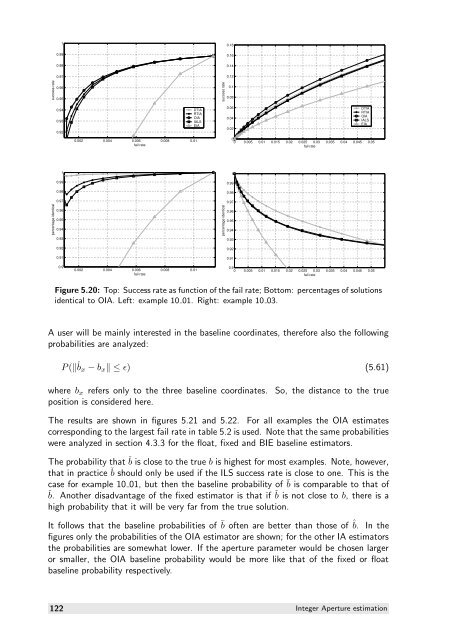The GNSS integer ambiguities: estimation and validation
The GNSS integer ambiguities: estimation and validation
The GNSS integer ambiguities: estimation and validation
You also want an ePaper? Increase the reach of your titles
YUMPU automatically turns print PDFs into web optimized ePapers that Google loves.
success rate<br />
percentage identical<br />
1<br />
0.99<br />
0.98<br />
0.97<br />
0.96<br />
0.95<br />
0.94<br />
0.93<br />
0.92<br />
1<br />
0.99<br />
0.98<br />
0.97<br />
0.96<br />
0.95<br />
0.94<br />
0.93<br />
0.92<br />
0.91<br />
0.9<br />
DTIA<br />
RTIA<br />
OIA<br />
IALS<br />
EIA<br />
0.002 0.004 0.006<br />
fail rate<br />
0.008 0.01<br />
0.002 0.004 0.006<br />
fail rate<br />
0.008 0.01<br />
success rate<br />
percentage identical<br />
0.18<br />
0.16<br />
0.14<br />
0.12<br />
0.1<br />
0.08<br />
0.06<br />
0.04<br />
0.02<br />
0<br />
0 0.005 0.01 0.015 0.02 0.025 0.03 0.035 0.04 0.045 0.05<br />
fail rate<br />
1<br />
0.99<br />
0.98<br />
0.97<br />
0.96<br />
0.95<br />
0.94<br />
0.93<br />
0.92<br />
0.91<br />
DTIA<br />
RTIA<br />
OIA<br />
IALS<br />
EIA<br />
0.9<br />
0 0.005 0.01 0.015 0.02 0.025 0.03 0.035 0.04 0.045 0.05<br />
fail rate<br />
Figure 5.20: Top: Success rate as function of the fail rate; Bottom: percentages of solutions<br />
identical to OIA. Left: example 10 01. Right: example 10 03.<br />
A user will be mainly interested in the baseline coordinates, therefore also the following<br />
probabilities are analyzed:<br />
P ( ˙ bx − bx ≤ ɛ) (5.61)<br />
where bx refers only to the three baseline coordinates. So, the distance to the true<br />
position is considered here.<br />
<strong>The</strong> results are shown in figures 5.21 <strong>and</strong> 5.22. For all examples the OIA estimates<br />
corresponding to the largest fail rate in table 5.2 is used. Note that the same probabilities<br />
were analyzed in section 4.3.3 for the float, fixed <strong>and</strong> BIE baseline estimators.<br />
<strong>The</strong> probability that ˇ b is close to the true b is highest for most examples. Note, however,<br />
that in practice ˇ b should only be used if the ILS success rate is close to one. This is the<br />
case for example 10 01, but then the baseline probability of ¯ b is comparable to that of<br />
ˇ b. Another disadvantage of the fixed estimator is that if ˇ b is not close to b, there is a<br />
high probability that it will be very far from the true solution.<br />
It follows that the baseline probabilities of ¯ b often are better than those of ˆ b. In the<br />
figures only the probabilities of the OIA estimator are shown; for the other IA estimators<br />
the probabilities are somewhat lower. If the aperture parameter would be chosen larger<br />
or smaller, the OIA baseline probability would be more like that of the fixed or float<br />
baseline probability respectively.<br />
122 Integer Aperture <strong>estimation</strong>
















